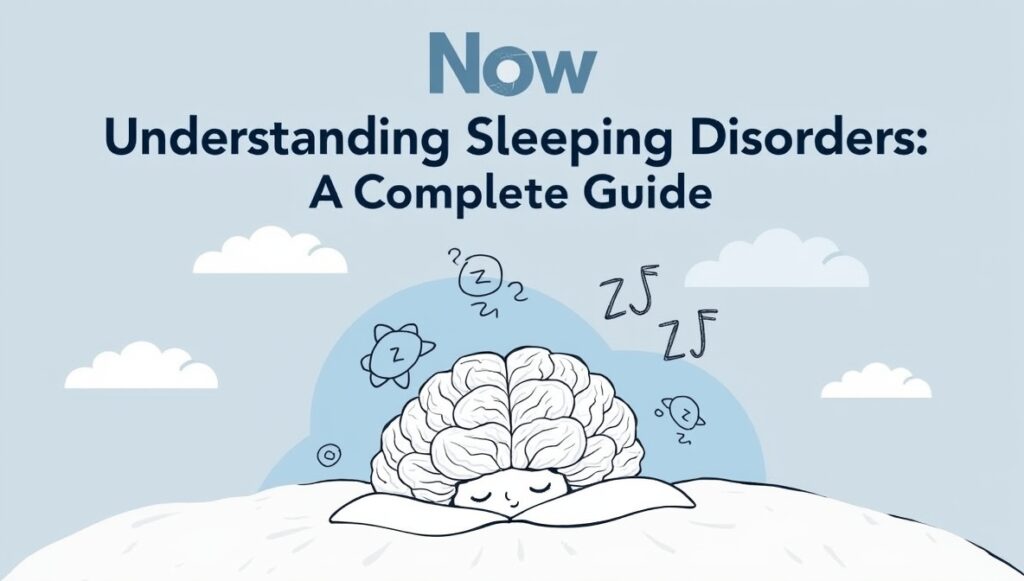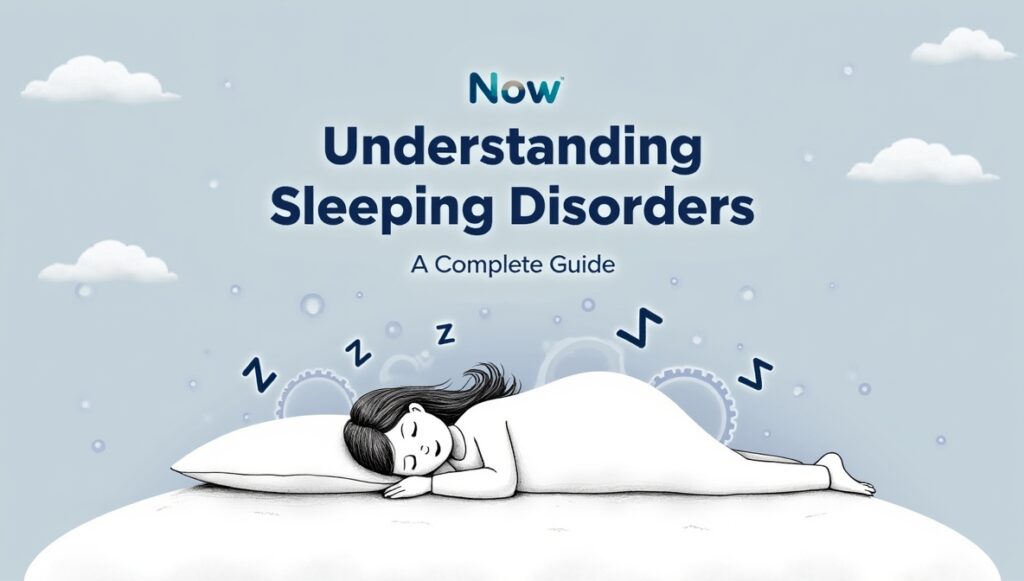Introduction
Sleeping disorders test: Sleep is a good thing, but millions of people around the world suffer from some sleep disorder, which is not good for them to enjoy their life to the best of their ability. One should have some idea about the Definition of Sleep Disorders to have some ideas about its cause, symptoms, and treatment in one’s mind. But. What are Sleep Disorders, and to whom do we belong?

Sleep disorder is a common sleep disorder. Killer disease. Health, namely heart disease, obesity, drowsiness, and brain deficiency. Here, we will discuss the most prevalent sleep disorder, the best treatments for sleep disorders, how to sleep, and how to stay healthy in general.
Sleep disorder is a disturbance in sleep, sleepiness, or wakefulness. They are based on diverse reasons such as stress, illness, psychological illness, and a frighteningly wide variety of cultures. Lack of sleep causes fatigue, irritability, poor concentration, and prolonged illness.
Five. Most common sleep disorders.
- Insomnia – Can’t. Fall asleep or stay asleep.
- Sleep Apnea – Requires. Middle-of-the-night awakenings.
- Restless Legs Syndrome (RLS) – Requires. Restless legs during rest
- Narcolepsy – Daytime. Excessive sleepiness and frequent attacks of sleep during the day.
- Circadian rhythm disorders – Trouble. With the body clock and therefore. Upwardly disrupted sleep.
All sleep disorders are diseases of someone and include the severity with the intensity of treatment for the pleasure of sleep quality.
Sleeping disorders test and Shortness of Breath
Talking about sleep disorders, breathing during sleep at night is also called the main cause. Sleep disorders are brought about by an attack of respiratory failure for the following three reasons.
- Obstructive Sleep Apnea (OSA) and Airway Obstruction
Nocturnal airway obstruction is the most common sleep disorder. OSA is a disease in which the soft tissues of the throat become inflamed and the airway becomes blocked at night, resulting in the following symptoms:
- Gasping
- Impaired breathing spell (apnea)
OSA is a cause and effect of sleep quality and induces daytime sleepiness, headaches, and intellectual deficits. The most traditionally used test is nocturnal polysomnography with nocturnal solitary apnea. OSA sleep disorder can be effectively treated with:
- CPAP therapy
- Lifestyle modification (e.g., weight loss, avoiding alcohol in the evening)
- Oral airway patency maintenance devices
2. Brain failure and central sleep apnea (CSA)
Central sleep apnea (CSA) differs from OSA in that CSA is a failure of the brain to transmit signals to the respiratory muscles. CSA is not a secondary loss of ventilation resulting from airway obstruction or collapse of the cerebral respiratory center. CSA is Cheyne-Stokes breathing:
- Crescendo-decrescendo breathing pattern (continuous increase followed by continuous decrease)
- Chronic obstructive pulmonary disease
CSA is a complication of an underlying medical condition such as heart failure, stroke, or kidney disease. CSA is managed by:
- Adaptive Servo Ventilation (ASV)
- Oxygen
- Management of the underlying medical condition
3. Pulmonary Function and Hypoventilation Disorders
Hypoventilation disorder is a complication of lung inflation and deflation during sleep, resulting in carbon dioxide retention and subsequent oxygen deprivation. Its etiology includes:

- Obstructive Sleep Apnea-Hypopnea Syndrome
- Obesity (Obesity Hypoventilation Syndrome)
- Chest wall disorders
- Disease of neuromuscular origin
- Respiratory depressant medication
Hypoventilation may progress to chronic bronchial asthma, which can lead to right-sided heart failure, hypovolemia, and erythrocytosis. In the following situations:
- Application of non-invasive ventilation (BiPAP)
- Weight loss
- Prevention of respiratory depressant drug administration
How can I get rid of my sleeping disorders test?
Sleep disorder is treated based on the nature and severity of the disorder. Here are standard methods that can improve sleep quality:
✅ Bedtime routine – Go to bed and wake up simultaneously every day.
✅ Sleep setting – Dark, quiet, cool.
✅ Sleep only in bed – Blue light is destroying the ease of sleep by suppressing melatonin release.
✅ Do not eat a full meal or consume caffeine two hours before bedtime – these will disrupt sleep.
✅ Winddown is achieved through habit – Stretch, breathe, meditate, and relax the body and mind.
The worst that could happen is that I will have to consult a sleep doctor and undergo a sleep study, and hopefully, some of these procedures will be recommended for me.
Sleeping disorders test a mental illness?
While sleep disorders are arguably mental illnesses, they are also comorbidities of depression, anxiety, and bipolar disorder. Axial sleep disorders will result in chronic mental illness, a cycle of aggressive sleep pain. The underlying mental illness will also need to be treated before attempting to eliminate aggressive sleep.
Mental illness resulting from sleep disorders is:
- Secondary insomnia due to stress and anxiety.
- Secondary sleep disorder and mood disorder
- Secondary insomnia PTSD
Treatment for psychiatric illness includes psychotherapy, cognitive behavioral therapy for sleep disorders, and medication for sleep disorders.
What are the four signs that you may have a sleep disorder?
One should ensure that an oversleeping disorder is diagnosed early in life so that a person can eliminate its additional effects on their health. The four most prevalent presentations of oversleeping disorder are:
- Daytime sleepiness – Excessive sleepiness in the morning with normal sleepiness.
Repeated loud snoring or forceful breathing – Most likely excessive sleepiness.
- Sleep disturbances or insomnia – Inability to sleep for hours.
- Mind and mood disorders – Forgetfulness, depression, and irritability.
See a medical doctor for nonspecific symptoms, diagnosis, and treatment.

Treatment of Sleep Disorders
Effective treatment of sleep disorders depends on the condition and etiology. Effective therapy is achieved through:
- Medications – Treatment of the disorder with insomniacs, antidepressants, and aphrodisiacs.
- Therapies include breathing exercises, relaxation techniques, and cognitive behavioral therapy (CBT) retraining.
- Equipment – CPAP machines, oral appliances, and oxygen replacement.
- Lifestyle Diet and Physical Exercises – Diet, sleep, and exercise.
Treatment and early diagnosis are the results of overcoming sleep disorders and living a healthier and happier life.
Pros and Cons of Sleep-Disordered Breathing
Pros
- Diagnosable and Explosive:
- Except for Obstructive Sleep Apnea (OSA) of intermittent breathing and Central Sleep Apnea (CSA), if a sleep test (polysomnography) is done, everything is normal for its diagnosis.
- CPAP therapy after diagnosis in the form of lifestyle adjustments, drug therapy, and treatment methods can correct symptoms and improve sleep.
2. High level of study and research:
- More treatment with more. More is studied and more is treated more uniformly.
- Treatment of sleep breathing disease, pathophysiology, and control.
3. Better quality of life after treatment:
- Better alertness after treatment, improved mental status and mood, and improved brain function.
- Improved clinical management of sleep apnea, peripheral hypertension, stroke, and coronary heart disease.
- Trained to treat subclinical diseases:
- Sleep disorder diagnosis is also an entry point for disease diagnosis and treatment.
Advantages
- Diagnostic level:
- Such patients have to undergo polysomnography as described above, and it is time-consuming and very expensive to diagnose sleep apnea.
- Delayed or incomplete diagnosis also has to tolerate hyper-symptoms and comorbidities.
- Treatment convenience:
- CPAP therapy, as the best obstructive sleep apnea treatment, keeps patients’ time and attention-depriving habits out of the daily routine.
- Behavioral changes, i.e., smoking cessation and weight loss, take time to initiate and are maintained by the patient.
- Medical Side Effects and Risks:
- Dryness, congestion, and puffiness are just a few of the many side effects of treatments like CPAP.
-/css-kit-forming, headache, and dizziness are some of the medications used to treat sleep disorders.
- No. Increased susceptibility to physical and emotional illness:
- Satisfaction, depression, lack of energy, and mental inefficiency are symptoms of uncomplicated sleep-disordered breathing.
- Hypoventilation and sleep deprivation due to chronic hypoxemia are damaging the brain, heart, and other organs.
- No. Fewer treatments are available.
- They have not considered sleep and specialized testing equipment outside the United States, and thus, the majority of patients will not receive equivalent treatment.
- They cannot afford to get tested and treated themselves because, for example, CPAP machines require a general health program.
Frequently Asked Questions (FAQs) About Sleeping Disorders Test
1. What are the three areas most likely to be responsible for nighttime breathing problems?
The three areas that are the site of nighttime breathing problems are:
1 – The brain, through the respiratory centers, controls the lungs.
- The upper airway, in which obstruction of the nasal or oral airway to the lungs is the cause of the problem.
- The chest or lungs, where there is a failure of lung expansion due to any lung disease, is evidence of respiratory failure.
**2. What is Obstructive Sleep Apnea (OSA)?
Obstructive sleep apnea is a rare condition in which the neck muscles relax at night, obstructing the airway to the lungs. The cause of breathing pauses and snoring, or gasping during sleep. A common condition that increases in frequency with age and is a possible cause of morning drowsiness as a result of disrupted sleep.
3. Obstructive sleep apnea – how is it diagnosed?
Obstructive sleep apnea is diagnosed after polysomnography or a sleep study. It is diagnosed in 15 or more episodes of airway obstruction and nocturnal apneas.
4. What are the most common symptoms of Obstructive Sleep Apnea?
The most common symptoms are:
–.Snoring
- Noisy breathing through the mouth at night
- Stopping breathing (apnea)
- Daytime drowsiness and non-restorative sleep
**5. What is Central Sleep Apnea (CSA)?
Central sleep apnea is caused by the collapse of the respiratory center of the brain. For each breath, the airway is never closed as in obstructive sleep apnea. The result is that the brain will never regulate breathing at night and therefore refuses to interrupt breathing at night.
It is diagnosed on polysomnography. Five or more apneas per hour with airway obstruction.
7. What is the relationship between Cheyne-Stokes Breathing and Central Sleep Apnea?
Cheyne-Stokes breathing is abnormal breathing with shortness of breath. It is a disease state in central sleep apnea with heart failure, stroke, and kidney disease.
**8. What are hypoventilation disorders?
Hypoventilation disorders
Poorly conditioned lung ventilation and sleep apnea. It causes the following diseases of the brain and heart: hypercapnia, hypoxemia, and oxygen depletion.
9. Why is hypoventilation disorder seen?
Hypoventilation disorder is caused by:
- Lung or chest wall disease
- Drugs (narcotic analgesics)
- Obstruction of lung movement due to obesity
10. What are the consequences of not treating hypoventilation disorders?
Failure to treat hypoventilation leads to:
- Right-sided heart failure
Encephalopathy (brain damage) - Arrhythmias (abnormal heart rhythm)
- Overproduction of red blood cells (polycythemia)
11. How common are sleep breathing disorders?
Sleep breathing disorders fall under three categories:
- Obstructive sleep apnea (airway disease)
- Central sleep apnea (brain or central nervous system disease)
- Hypoventilation disorders (pulmonary parenchymal or chest wall disease)
Conclusion: Sleeping disorders test
We urge you to read The Meaning of Sleep Disorders and Types of Sleep Disorders so that you can be reasonably well educated about their symptoms and treatments. You are a patient of Obstructive Sleep Apnea, Central Sleep Apnea, or a hypoventilation disorder. Sleep well and live a good life if you dream of good treatment. You do not sleep, and are never free from time. Get the benefit of better treatment from a doctor. Healthy sleep equals good health and a healthy life.
#SleepingDisordersTest
#SleepDisorderCheck
#OnlineSleepTest
#SleepHealthAssessment
#TestForSleepDisorders
#SleepApneaTest
#InsomniaTest
#SleepQualityCheck
#BetterSleepTest
#SleepDiagnosis

